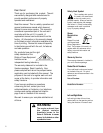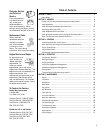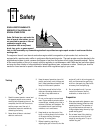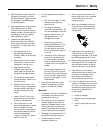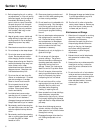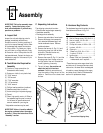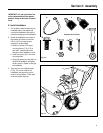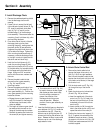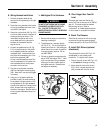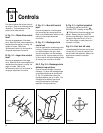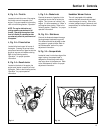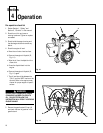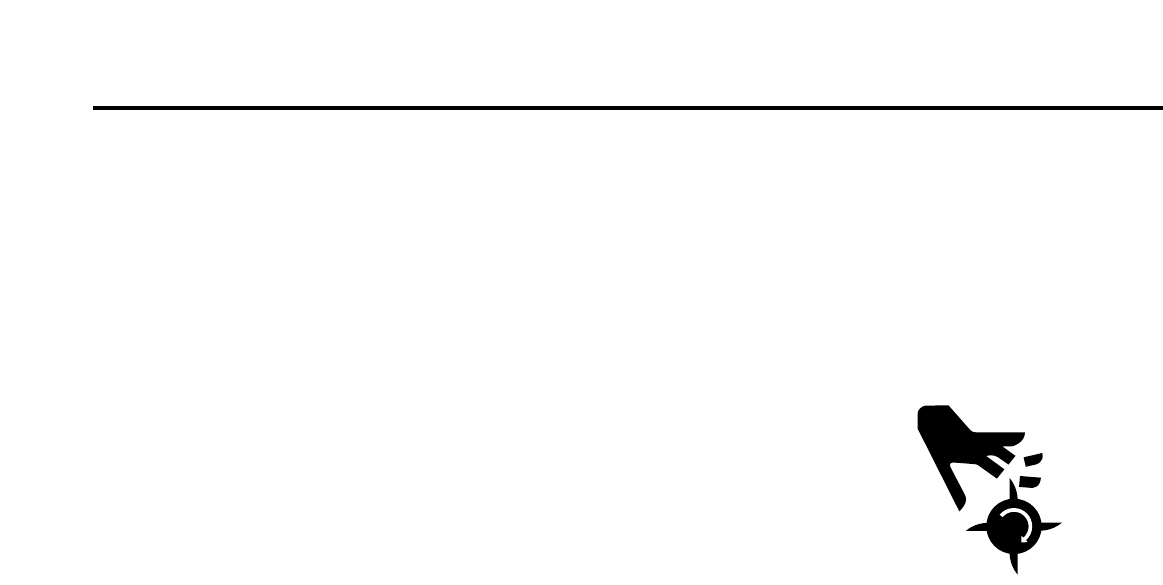
5
Section 1: Safety
3. Before starting the engine, check the
tightness of all screws, nuts, bolts,
and other fasteners. Replace or clean
any damaged or unreadable safety
and operating labels.
4. Wear adequate winter outer garments
when operating the unit. Wear
footwear that will improve footing on
slippery surfaces. Exercise caution to
avoid slipping or falling, especially
when operating in reverse.
5. Use extra care when handling
gasoline and other fuels. Gasoline
and its vapors are highly flammable
and explosive. To help prevent a fire
or explosion:
a. Store gasoline only in an
approved gasoline storage
container, safely out of the reach
of children.
b. Never remove the fuel fill cap on
the fuel tank, or add fuel while
the engine is running or hot.
c. Keep matches, smoking
materials, open flames, and
sparks away from the fuel tank
and gasoline storage container.
d. Fill the fuel tank outdoors and
with extreme care. Never fill the
fuel tank indoors.
e. Replace the fuel fill cap on the
fuel tank, the cap on the gasoline
storage container, and clean up
fuel spills before starting the
engine.
f. Leave 1/2-inch (2.5 cm) of air
space at the top of the fuel tank
to allow for fuel expansion.
g. Do not store the unit or the
gasoline storage container where
there is a danger of an open
flame or spark, or where ignition
sources are present such as hot
water and space heaters,
furnaces, clothes dryers, stoves,
electric motors, etc.
6. For units equipped with the electric-
start kit:
a. Only use a 3-pronged, UL rated
and approved, outdoor use
electrical cord.
b. Only plug into a properly
grounded, 3-pronged outlet. Do
not use any adapters on the cord.
c. Inspect the electrical cord for
damage before use. If it is
damaged, do not use it.
d. Stand on dry ground when
handling the electrical cord. Do
not handle the electrical cord
with wet hands or wet gloves.
Do not use the electric starter if it
is raining.
e. Connect the cord to the electric
starter first, and then plug the
cord into a properly grounded
outlet (this lessens the chances
of sparks from occurring near the
engine).
f. Do not abuse the electrical cord.
Do not pull the unit by the cord.
Do not pull the cord to disconnect
it from the outlet. Keep the cord
away from sharp edges, oil, and
excessive heat.
7. Adjust the skid shoes and scraper
blade so the auger housing clears
gravel or crushed rock surfaces.
Operation
1. The operator of the unit is responsible
for the safety of all persons in the
operating zone of the unit.
2. Before starting the unit, disconnect
the spark plug wire and check the
auger and discharge chute to make
sure they are free of ice. Check the
engine oil level. Reconnect the spark
plug wire before starting the engine.
3. Disengage all clutches and shift into
neutral before starting the engine.
4. Let the unit adjust to outdoor
temperature before use.
5. Check the operation of the controls
before using the unit. Do not operate
the unit unless all controls are
operating properly.
6. Never carry passengers on the unit.
They could fall off and be seriously
injured, or they could interfere with
safe operation.
7. Keep hands, other body parts, and
clothing away from any moving or
rotating parts. Keep clear of the intake
and discharge openings at all times.
8. Before starting the engine, inspect the
area where the unit is to be used and
remove all sleds, boards, doormats,
metal, bottles, cans, or other debris.
9. Keep children out of the area of
operation and under the watchful eye
of an adult not operating the unit.
Never assume that children will
remain where you last saw them.
10. If the unit makes an unusual noise or
vibration, immediately shut the engine
off, wait for all moving parts to stop,
disconnect the spark plug wire from
the spark plug and perform the
following steps:
a. Inspect for damage.
b. Replace or repair any damaged
parts.
c. Check for and tighten any loose
parts.




